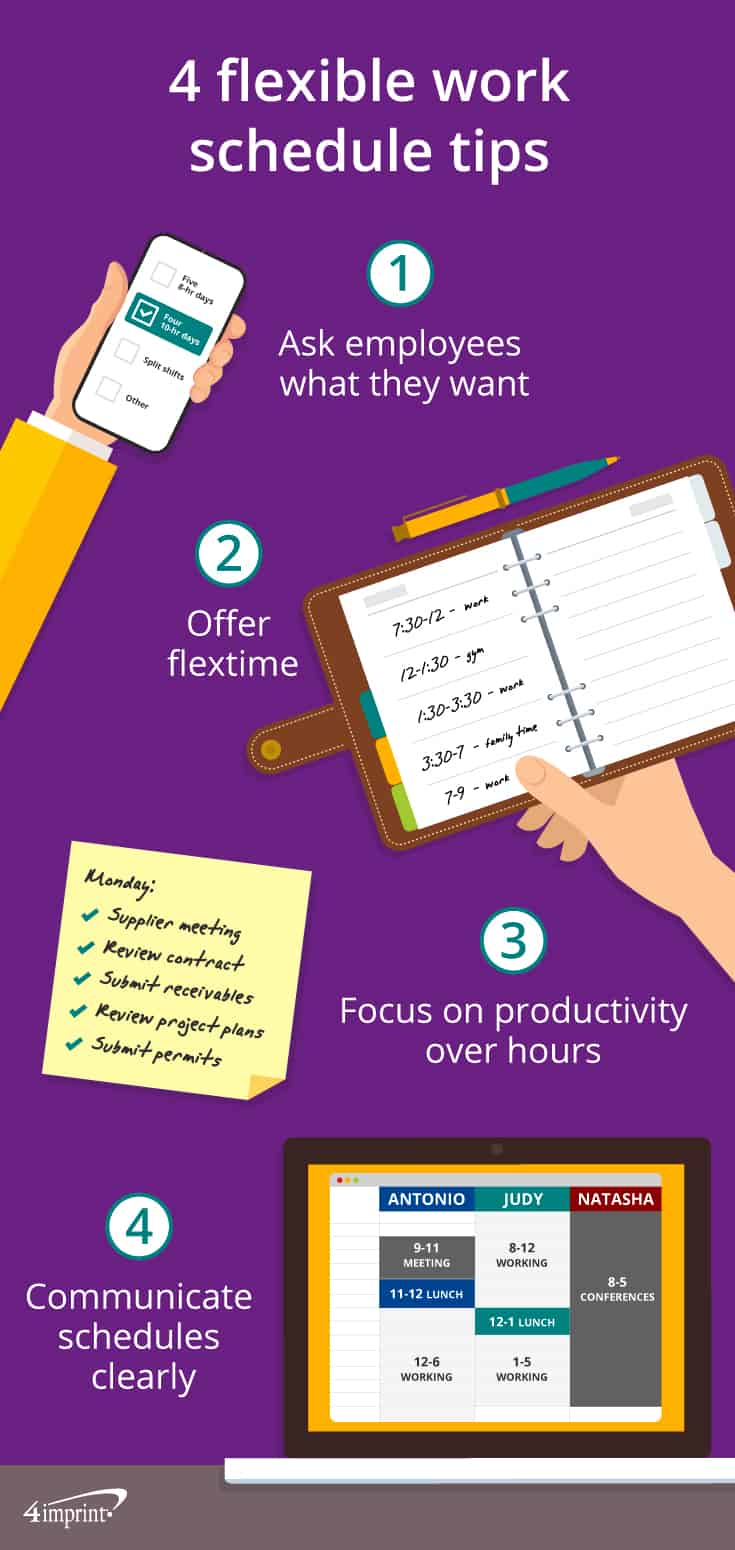In 2020, the number of people working from home skyrocketed, thanks to the worldwide pandemic.
Only 20% of Canadian employees working remotely want to return to the workplace full-time post-pandemic.
Being able to choose where to work used to be considered a flexible work schedule. But now that remote work is so commonplace, a flexible work schedule is about deciding when to work.
Instead of working the traditional 9-to-5 schedule, an employee may want to work early morning to mid-afternoon. Or work a split shift. Or work a weekend day and take off one weekday. Allowing this kind of flexibility has big payoffs—80% of employees said they would be more loyal if they had flexible work options.

If you’re looking for ideas on how you can provide a more flexible work schedule for your team, read on.

Ask employees what they want
The first step in creating a flexible schedule that helps retain more employees and boosts loyalty is simple: ask your team what they’d like. Do they want to work a split shift instead of eight hours straight? Do they want the freedom to log on and off throughout the day? Do they want to stop clocking hours altogether and move toward a focus on completing tasks?
Once you develop a new schedule, allow time to adjust and work out any kinks that may crop up. You also may want to do a trial run before committing completely. Kick off excitement for the new schedule with gifts for your team—like a durable water bottle or delicious chocolate chip cookies.
Offer “flextime”
Maybe your team consists of parents with young kids who are trying to juggle school or daycare with work. Or perhaps you have employees who want to volunteer more but can’t do it with a rigid work schedule. Offering “flextime” allows your team to fit their work around their personal life and other responsibilities. Flextime is typically defined as a standard number of hours within a specified period, like a week. This means employees can choose when they start and stop work as long as they are still hitting the required number of hours. Allowing this kind of flexible schedule can also lead to a stronger bottom line—60% of flexible workers say the setup makes them more productive and engaged during worktime.
Focus on productivity, not hours
Some businesses focus on productivity and quality rather than the number of hours worked. In fact, burning the midnight oil has been found to be counterproductive.One study found that productivity per hour declines sharply when a person works more than 50 hours a week. After 55 hours, productivity drops so much that any work gains were erased.
And working up to 70 hours a week only accomplishes the same amount of work as putting in 55 hours.
Focusing on productivity means employees’ success is based on actual output rather than hours worked. To help make the switch, consider a rewards system that provides gifts for your team for the first six months. Each month, those who complete all their assigned tasks get a wireless charging hub or branded T-shirt.
Clearly communicate schedules
Flexible work schedules rely on clear and frequent communication. Ask employees to post their work schedule where everyone else can see it. Provide everyone with a monthly planner and a fun light-up pen, so they can jot notes about coworkers’ schedules as well as their own.
Encourage your team to be clear with one another about goals and expectations. Going above and beyond to ensure clear communication with flexible work schedules will help prevent friction, missed deadlines and misunderstandings.
Boost loyalty with flexibility
Providing a flexible work schedule can boost loyalty, productivity and engagement. If you’re considering a switch from traditional schedules, you’ll likely have a happy team that enjoys getting their work done at the most convenient times for them.
Top Takeaways:
- Ask your team what they’d like to see in a flexible work schedule
- Focus on productivity rather than how many hours were clocked
- Allow your team to decide what time to start and stop working
- Communicate to ensure everyone’s on the same page
